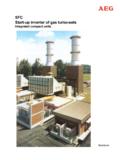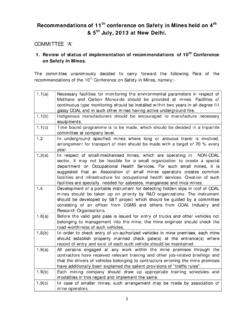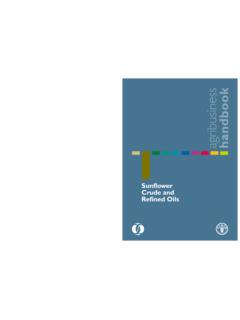Transcription of LITTLE CHRONOLOGY - aeg-ie.com
1 LITTLE CHRONOLOGYThe directors of DEG, Emil Rathenau (1838 1915) and Oskar von Miller (1855 1934), engineer and founder of the Deutsches MuseumThe first price list published by DEG in 1883 Photo: Deutsches MuseumIn the early days of the electrical industry, the most widespread and popular use of electricity was for electric lighting. The mechanical engineer Emil Moritz Rathenau had got to know Edison s system of illumination during a visit to the first International Electricity Exhibition in Paris in 1881. In 1882 he spread the message in Germany that electricity could soon provide light and power on demand and operate lights in homes and machines in factories at the same time. Almost 130 years ago in Berlin, on 19th April 1883, Rathenau founded the predecessor of what later became the Allgemeine Elektricit ts-Gesellschaft (General Electricity Company) under the name Deutsche Edison-Gesellschaft f r angewandte Elektricit t (German Edison Company for Applied Electricity, DEG) to promote the commercial use of the German rights to Edison s patent incan-descent light, which Rathenau had acquired.
2 In 1887, DEG was renamed Allgemeine Elektricit ts-Gesellschaft (AEG).AEG significantly contributed to electrification in Germany and abroad and quickly rose to become the largest German electrical company with a world-wide AEG concern is now history, but the brand lives on. The slogan aus Erfahrung gut AEG (Good from experience - AEG) is a testimony to quality from Germany. The Berlin company, AEG Industrial Engineering GmbH is committed to the quality and tradition of the historical AEG group. In publishing this LITTLE CHRONOLOGY says Heinrich Otterpohl, founder and manager of AEG IE and a member of the Walther Rathenau foundation, we want to acknowledge the industrial legend that is AEG, but above all we want to acknowledge the people who are inseparably connected with the name AEG .IN THE BEGINNING WAS LIGHT 19th April, 1883 | Deutsche Edison-Gesellschaft f r angewandteElektricit t (DEG) founded.
3 8th May, 1884 | DEG establishes its first subsidiary, the St dtische Elektricit ts-Werke AG zu Berlin ( ) with a share capital of 3 million Marks. 12th August, 1884 | The enters into a concession contract with the city of Berlin, thus assuming the task of supplying Berlin s electricity. 13th September, 1884 | Commissioning of the first DEG block power station in a basement at the corner of Unter den Linden and Friedrichstra e 85, with an output of 100 kW DC and a voltage of 100 V. It supplies Caf Bauer and the neighbouring shops and restaurants. 15th August, 1885 | The first public power station in Germany starts operation. Built by DEG at Markgrafenstrasse 44, it houses six steam engines each producing a good 100 kW (150 horsepower). Barely a year later, a second central power station of comparable size is set up in Mauerstrasse. Its customers are the K nigliche Schauspielhaus and the Reichsbank.
4 1887 sees the first link between two networks fed from these individual power stations. 1885 | DEG is the first German industrial company to begin building a network of branches both at home and abroad. (First German branch in Munich in 1885, first foreign branch established in Madrid in 1889.)Glass blowers in the company s own light-bulb factory, Schlegelstrasse 26 Central power station, Markgrafenstrasse 44 Caf Bauer illuminated by filament lamps Emil RathenauOskar von MillerDistribution of electricityGeneration of electricity 23rd Mai, 1887 | DEG is restruc-tured and becomes AEG (Allgemeine Elektricit tsgesellschaft). October 1887 | AEG assumes the administration of the company and establishes the Berliner Elektricit ts-Werke (BEW). The directors are Emil Rathenau, Oskar von Miller and Felix Deutsch (1884 1964). In the same year, the production of steam engines, dynamo generators, electric motors, vehicles, lifting equipment, pumps, fans and installation material begins in the machine works in Ackerstrasse in Berlin.
5 1888 | AEG enters into the business of building electric railways. 1889 sees the establishment of a railways section and the delivery of the first mining locomotives. 1889/90 | The long-standing chief designer at AEG, Michail von Dolivo- Dobrowolsky (1862 1919), the father of three-phase AC technology invents both the squirrel-cage rotor asynchro-nous motor in 1889 and the three-phase cage rotor transformer in 1890. His inventions provide practical applications for three-phase AC power. After the first single cage motor he later also builds his first double cage version. Today, the asynchronous motor is the most widely used electric motor. 1891 | The first of its kind in Europe: AEG sets up a complete electrical tram network and system in Halle an der Saale. By mid-1896 there are already 34 tram systems in operation or under construction. By 1900 the number has risen to 70 tram systems 1475 km of tramlines and 2700 motorised tram carriages.
6 25th August, 1891 | At the Inter-national Electro-technical Exhibition in Frankfurt, Main the first long-distance transmission of electrical energy is made over a distance of 176 km between Lauffen am Neckar and Frankfurt, Main using AEG plant equipment with high-voltage three-phase current at V. This exhibition in Frankfurt proves that electricity can be transmitted over great distances with low line losses and that the development of power stations for whole regions is possible. Alternating current systems are suitable for both lighting equipment and the operation of motors and are therefore better than direct current systems. This exhibition stimulates the public and private demand for the new energy electricity. 1892 | The company starts producing its own household appliances. 1895 | AEG builds Germany s first, three-phase power station, Kraftwerk Oberspree. Industrial firms are its main customers.
7 1899 | Moabit power station is commissioned, delivering electricity at 6 kV and is thus able to supply a wider area. After the contracts with Siemens ended in 1894, power station business is made an independent division under the leadership of Walther Rathenau (1867 1922). At the turn of the century, AEG has built around 248 power stations at home and abroad with a total output of 1897 the company starts production of Nernst Lamps after their invention by the chemist, Professor Walther Nernst (1864 1941). The Nernst Lamp is more efficient than the carbon filament lamp. A ceramic rod of zirconium oxide and yttrium oxide is used as the light source (Nernst rod). 1900 | Hair dryer invented. (In 1908 the German term F n (hair dryer) is registered as a word and image trademark for AEG Hausger te GmbH, Nuremberg, and from 1941 the word FOEN is registered as a word and image trademark).
8 Around 1900 | At the turn of the century AEG has 140 branch offices and subsidiaries world-wide and numerous factories in and around Berlin. Erich Rathenau (1871 1903) and Walther Rathenau join AEG s Board of Directors. In May 1902 Walther Rathenau steps down from the Board of Directors and becomes the owner of the affiliated company Berliner Handels-Gesellschaft (BHG) until 1907. From 1904 he is on the Supervisory Board of AEG and becomes its chairman in 1912. 1901 | The Neue Automobil-Gesellschaft is founded. (NAG; renamed Nationale Automobil-Gesellschaft from 1915.) 27th May, 1903 | AEG and Siemens & Halske, acting on the instructions of Kaiser Wilhelm II., form a company called Gesellschaft f r drahtlose Telegraphie (Wireless Telegraphy Company, Telefunken). The Kaiser wants to avoid the Army and Navy using different radio April 1923, the company is renamed Telefunken Gesellschaft f r drahtlose Telegraphie , which was the company name until 1955.
9 27th October, 1903 | An AEG three-phase high-speed railcar achieves a new world record speed of km/h on the Royal Prussian Military Railway between Marienfelde and Zossen in direct competition with Siemens & 1911, the first electrified long distance railway in Germany comes into operation between Bitterfeld and s Certificate of IncorporationMichail von Dolivo-Dobrowolsky enters the Hall of Fame with his three-phase electric : Irene Ahrens, BerlinMichail von Dolivo-DobrowolskyWalther RathenauAlternating current transmission Lauffen to FrankfurtAEG s World Record Railway Adjustment mechanism for arc lamp and Nernst Lamps 1907 1914 | AEG recruits one of the most avant-garde artists of the time, the painter, typographer, graphic artist and architect Peter Behrens (1868 1940) as an artistic consultant. Behrens artistic development predestines him to a congenial collaboration with industry and to develop and implement a com-pletely new novel design philosophy.
10 His primary goal is to improve craft products which are mass produced, and this meets a widespread initial graphical assignments, in 1907 AEG entrusts him with the first product design tasks for an area which is the most widespread and popular use of electricity at the time electric lighting. Behrens is asked to design artistic forms for carbon arc lamps and all accessory items. In redesigning the housings for arc lamps, AEG and Behrens are pursuing a concept which is revolutionary for its time. Form must no longer copy any historical style, any craftsmanship skills or any other materials (other than those actually used). It must no longer deny the industrial production processes, rather it must emphasise them and the mechanical production methods must be carried out exactly. AEG has taken the step of harmonising arc lamps with the artistic demands of modernism. Peter Behrens is seen as the prototype industrial designs for arc lamps using a revolu-tionary repertoire of form based on the reduced geometrical shapes of the triangle, square and circle, and they set the scene for a whole new culture of design: industrial art or industrial 1907 he designs the world s first ever industrial product the Economy Arc Lamp.







